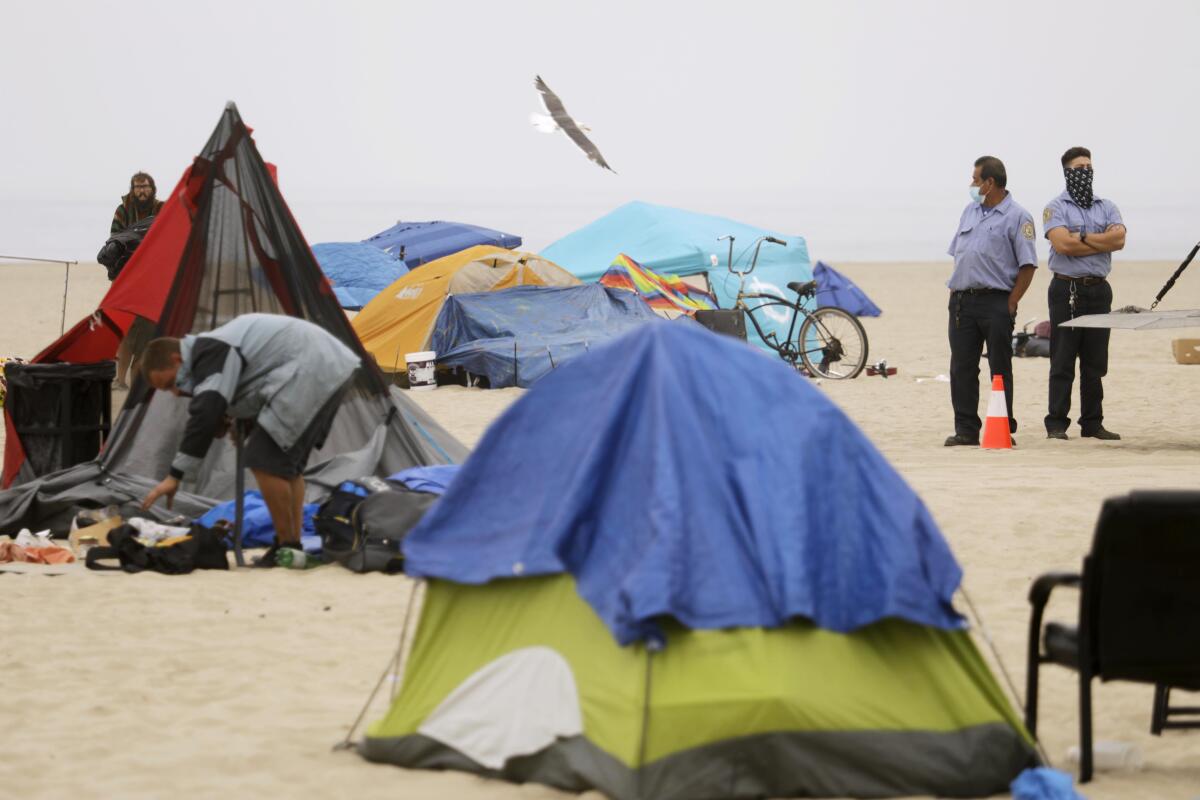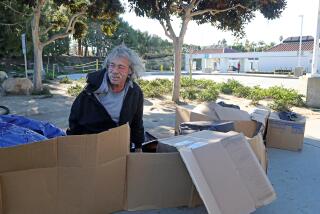L.A.’s new homeless encampment law: A humane approach or cruel to unhoused people?

- Share via
A sweeping ordinance outlawing camping around parks, libraries and other facilities was approved last week by the Los Angeles City Council. Mayor Eric Garcetti quickly signed the ordinance, which is expected to go into effect next month.
The ordinance marks the city’s latest attempt to address homeless camping at a time when business leaders, neighborhood groups and others are voicing alarm over reduced access to sidewalks, parks and other public spaces.
Backers have called the ordinance a more humane way to clear encampments, with outreach teams offering shelter and services before any enforcement takes place. Critics say it punishes people for living on the street and argue that the city should put its energies into building housing for the city’s neediest people.
What does it do?
The ordinance prohibits sitting, sleeping or storing items on public property near “sensitive” uses — libraries, parks, daycare centers and schools. But it also states that enforcement in any of those locations would not occur until the City Council has reviewed each location and voted to give the go-ahead.
Council votes also would be required for the ordinance to be enforced on public areas near freeways, bridges, railroad tracks and recently built homeless shelters. In addition, the council would need to weigh in if the city determined that an encampment is an ongoing threat to public safety.
Still, votes would not be needed for every situation. Under the ordinance, city crews could move ahead when:
- Tents or other objects are found to be within two feet of a fire hydrant.
- People are found to be sitting, sleeping or storing property within five feet of a building’s usable entrance or within 10 feet of a driveway.
- Tents or other objects are obstructing the street or a bicycle path.
- Encampments or tents are blocking sidewalks in ways that prevent wheelchair users from traveling on them, in violation of the federal Americans With Disabilities Act, the landmark civil rights law.
Some critics have said the process is too bureaucratic, saying the council would have to vote encampment by encampment on whether to enforce its own law. They also warn the law would be carried out differently in different parts of the city, depending on the political views of that area’s council member.
How would it work?
Once an area is approved for enforcement by the City Council, signs would need to be installed, followed by a 14-day public notice period. Enforcement would be accompanied by a “street engagement strategy,” with social workers and others reaching out to a particular encampment over a period that could last up to four months.
The city’s policy analysts have recommended assigning 17 outreach teams from the Los Angeles Homeless Services Authority to handle that work. Those teams would head out to an area before the City Council votes to prohibit camping in a particular location, according to a proposal released last week.
Once an area is cleared, outreach workers would return over a period of three months to see if homeless people return. If they come back, additional outreach would be conducted to promote “voluntary compliance.”
Violations of the ordinance would be treated as infractions and could result in the issuing of citations. However, those who are found to have willfully resisted enforcement could be subject to a misdemeanor, City Atty. Mike Feuer said.
What’s been the reaction?
Many homeless advocates are furious over the proposal, saying there still is not enough shelter space to serve the city’s unhoused population, which exceeded 41,000 during the city’s last official count. Protesters showed up last week outside Garcetti’s home, with some throwing garbage on the property and scrawling graffiti calling for the ordinance to be repealed.
Council members Mike Bonin and Nithya Raman have come out against the law, saying the city failed to prepare information showing where it would be safe for people to legally camp. Meanwhile, a team of UCLA health researchers posted their own online map showing many of the locations that could be covered by the ordinance.
Chelsea Shover, assistant professor in residence in UCLA’s David Geffen School of Medicine, said she and her students found that if every location identified in the ordinance were off-limits, there would be few areas left where people could sleep or camp, particularly in downtown and parts of South Los Angeles.
In a lengthy post, Shover and two of her colleagues said the law would effectively criminalize homelessness in the areas highlighted on their map.
Feuer disagreed with that take, arguing that the new law focuses on conduct, not the status of experiencing homelessness. He said he has long believed that “sensitive” locations such as schools are incompatible with homeless encampments.
“It makes sense to say that you can’t encamp next to a fire hydrant or block [wheelchair] access and so on,” he said. “I think public spaces should be safe and accessible for everyone.”
Times staff writer Doug Smith contributed to this report.
More to Read
Sign up for Essential California
The most important California stories and recommendations in your inbox every morning.
You may occasionally receive promotional content from the Los Angeles Times.












